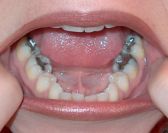Stay Informed
Popular Articles
- Hiatal Hernia: Hidden Cause of Chronic Illness
- Small Intestinal Bacterial Overgrowth (SIBO)
- Applied Lymphology: Unlocking the Secret to Pain Relief
- An Introduction to Constitutional Iridology
- The Low Down on Liver Detoxification
- An Energetic and Emotional Approach to Cancer
- Fat Facts
- Marrow in the Bones
- Blood Type and Nutrition
- Cardiac Herbs: Beyond Hawthorn
Quick Search
The School of Modern Herbal Medicine




Interesting Facts About Amalgams
- 11/11/2008
- Categorized in: General Health
This is page 2 of a four-part article.
 My position on amalgams is very different than the position taken by the FDA (Food and Drug Administration) and the ADA (American Dental Association). They regard amalgam as a generally “safe” material.
My position on amalgams is very different than the position taken by the FDA (Food and Drug Administration) and the ADA (American Dental Association). They regard amalgam as a generally “safe” material.
However, I find it odd that two other branches of the government (OSHA and EPA) have determined that mercury is so toxic to human health that levels of mercury should be practically eliminated from the environment and the workplace. Yet, somehow having that same mercury in your mouth is considered perfectly safe! This doesn't make sense to me.
Fortunately, it doesn't make sense to my dentists either. I consider myself very fortunate to have a pair of very talented holistic dentists in the office building next to mine. Dr. Becky Patton, who started the practice, has shared some interesting facts about dental amalgams that I'd like to pass on to you.
First, when she was in dental school and they were learning how to mix and use amalgam fillings, they were told that if they accidentally dropped any amalgam they would have to vacate the room. Then, a HAZMAT team would have to be brought in for clean-up because the stuff posed an environmental hazard. (She had the same question that I have—if this stuff is so toxic that it requires a HAZMAT team to clean it up from the environment, how can you put it in people's mouths?)
Second, she tells me that amalgams are considered hazardous materials and are shipped as such. Old amalgam fillings are considered hazardous waste and have to be dealt with as such. The package even says that the material is toxic and should not be used on children or women who are pregnant or nursing. Now, isn't that interesting?
What's even more interesting is that amalgam, according to Dr. Patton, is a very poor material to use for dental fillings. Here's why. Remember the mercury in those thermometers? Mercury was used in thermometers because it expands and contracts dramatically with heat and cold.
So, when you drink or eat something hot, the mercury in the filling expands. This puts pressure against the structure of the tooth and causes very tiny hairline fractures in the tooth. Then, when you eat or drink something cold the filling contracts. This creates a tiny gap between the tooth and the filling that allows bacteria to get in between the filling and the tooth. This means that amalgam fillings don't last as long as composites, which actually bond with the tooth and expand and contract with it.
Dr. Patton says she has no trouble billing insurance companies for removing amalgam fillings and replacing them because she has never found one that doesn't have decay underneath the filling. She even has a standing offer that if she ever removes a mercury filling and there's no decay under it, she'll replace it for free. She has yet to replace one for free!
Mercury has been used in medicine for a long time. In the early 1800s, a drug called Calomel, a compound of mercury was used to treat fevers, colds, tuberculosis (they called it "consumption") and other acute illnesses. Samuel Thomson, an herbalist of the day, called using mercury and other poisons as medicine, “learned ignorance.” I think there's still some “learned ignorance” in our society, when mercury continues to be used in dental amalgams, vaccines and other “health care” applications.
